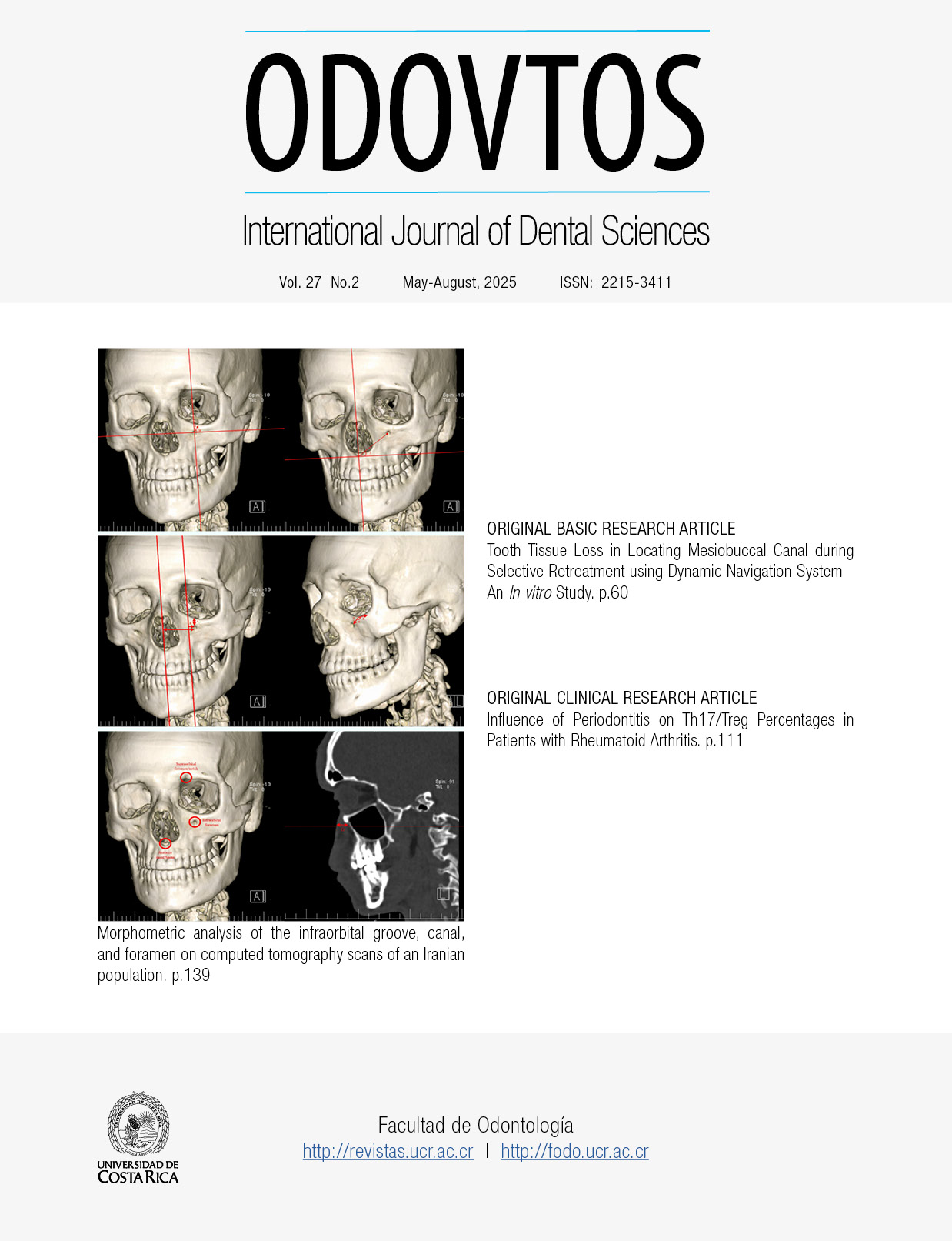Abstract
To evaluate the intratubular penetration depth of ultrasound-activated bioceramic sealant cements into root dentin, specifically at the dentin-cement interface. This in vitro experimental study was conducted with samples that were randomly divided based on the type of sealer used and whether ultrasound activation was applied prior to obturation. This resulted in four experimental groups (n=40). Groups A1 and B1 utilized the Eighteeth Ultra X ultrasonic activator with a blue tip #20 featuring a 2% taper at low power for activation, while groups A2 and B2 did not employ any form of activation. The symbol (+) denotes groups with ultrasonic activation, while (-) represents groups without ultrasonic activation. In the middle third, it was observed that BioC Sealer (+) had a mean sealing value of 0.66±0.17, while MTA Fillapex (+) showed a mean value of 0.38±0.07. It was found that BioC Sealer (-) had a mean sealing value of 0.24±0.04 in the middle third, while MTA Fillapex (-) showed a mean value of 0.16±0.04. These differences were not statistically significant (p=0.569). In the apical third, the BioC Sealer (-) presented a mean sealing value of 0.44±0.17, while the MTA Fillapex (-) obtained a mean value of 0.30±0.04. However, this difference did not reach statistical significance (p=0.0745), suggesting that both materials can provide a similar seal in the apical third. The results suggest that both BioC Sealer and MTA Fillapex provide a comparable seal in the middle and apical thirds of the root canal system, however, this was not statistically significant. This indicates their potential efficacy in both endodontic sealing procedures.
References
Kokkas, A.B.; Bousioukis, A.; Vassiliadis, L.P.; Stavrianos, C.K. The influence of the smear layer on dentinal tubule penetration depth by three different root canal sealers: an in vitro study. J. Endod. 2004, 30: 100-102.
Zordan-Bronzel C.L., Esteves Torres F.F., Tanomaru-Filho M., Chávez-Andrade G.M., Bosso-Martelo R., Guerreiro-Tanomaru J.M. Evaluation of Physicochemical Properties of a New Calcium Silicate-based Sealer, Bio-C Sealer. J Endod. 2019; 45 (10): 1248-125.
Cáceres C., Larrain M.R., Monsalve M., Peña Bengoa F. Dentinal Tubule Penetration and Adaptation of Bio-C Sealer and AH-Plus: A Comparative SEM Evaluation. Eur Endod J. 2021; 6 (2): 216-220.
Huang Y., Orhan K., Celikten B., Orhan A.I., Tufenkci P., Sivimay S. Evaluation of the sealing ability of different root canal sealers: a combined SEM and micro-CT study. J Appl Oral Sci. 2018; 26: 1-8.
Jitaru S., Hodisan I., Timis L., Lucian A., Bud M. The use of bioceramics in endodontics - literature review. Med Pharm Reports. 2016; 89 (4): 470-3.
Alves Silva E.C., Tanomaru-Filho M., da Silva G.F., Delfino M.M., Cerri P.S., Guerreiro-Tanomaru J.M. Biocompatibility and Bioactive Potential of New Calcium Silicate-based Endodontic Sealers: Bio-C Sealer and Sealer Plus BC. J Endod. 2020; 46 (10): 1470-1477.
Donnermeyer D., Bürklein S., Dammaschke T., Schäfer E. Endodontic sealers based on calcium silicates: a systematic review. Odontology. 2019; 107 (4): 421-436.
Sanz J.L., López-García S., Lozano A., Pecci-Lloret M.P., Llena C., Guerrero-Gironés J., Rodríguez-Lozano F.J., Forner L. Microstructural composition, ion release, and bioactive potential of new premixed calcium silicate-based endodontic sealers indicated for warm vertical compaction technique. Clin Oral Investig. 2021; 25 (3): 1451-1462.
Blanco, R.R.; Goldman, M.; Lin, P.S. The influence of the smeared layer upon dentinal tubule penetration by plastic filling materialsJ. Endod. 1984, 10: 558-562.
Mamootil, K.; Messer, HH Penetración de los túbulos dentinarios por cementos selladores endodónticos en dientes extraídos e in vivo. En t. Endod. J. 2007, 40: 873-881
Balguerie E., Lucas V., Karan V., Marie G. Sealer penetration and adaptation in the dentinal tubules: a scanning electron microscopic study. J Endod. 2011; 37: 1576-9
Krithikadatta J., Gopikrishna V., Datta M. CRIS Guidelines (Checklist for Reporting In-vitro Studies): A concept note on the need for standardized guidelines for improving quality and transparency in reporting in-vitro studies in experimental dental research. J Conserv Dent. 2014; 17 (4): 301-4.
Almeida J.F.A., Gomes B.P.F.A., Ferraz CCR, Souza-Filho FJ, Zaia AA. Filling of artificial lateral canals and microleakage and flow of five endodontic sealers. Int Endod J 2007; 40: 692-9
Piai G.G., Duarte M.A.H., Nascimento A.L. do, Rosa R.A. da, Só M.V.R., Vivan R.R. Penetrability of a new endodontic sealer: A confocal laser scanning microscopy evaluation. Microsc Res Tech 2018; 81: 1246-9.
Arslan H., Abbas A., Karatas E. Influence of ultrasonic and sonic activation of epoxy-amine resin-based sealer on penetration of sealer into lateral canals. Clinical Oral Investigations. 2016; 20: 2161-2164.
Perez-Alfayate y cols 15 Pérez-Alfayate R, Algar-Pinilla J, Mercade M., Foschi F., Sonic Activation Improves Bioceramic Sealer’s Penetration into the Tubular Dentin of Curved Root Canals: A Confocal Laser Scanning Microscopy Investigation. Appl. Sci. 2021; 11 (9): 3902
Bem I.A.D., Oliveira R.A. de, Weissheimer T., Bier C.A.S., Só M.V.R., Rosa R.A. da. Effect of Ultrasonic Activation of Endodontic Sealers on Intratubular Penetration and Bond Strength to Root Dentin. Journal of Endodontics. 2020; 46 (9): 1302-8.
Makan K., Dhawan R., Kukreja N., Sharma S., Maity K., Sachdev M. Effect of ultrasonic agitation on the penetration depth of different root canal sealers: An in vitro study. International Journal of Health Sciences 2022; 6 (1): 6493-6504.
Wiesse P.E.B., Silva-Sousa Y.T., Pereira R.D., Estrela C., Domingues L.M., Pécora J.D., et al. Effect of ultrasonic and sonic activation of root canal sealers on the push-out bond strength and interfacial adaptation to root canal dentine. International Endodontic Journal. 2018; 51 (1): 102-11.
Guimarães B.M., Amoroso-Silva P.A., Alcalde M.P., Marciano M.A., Bombarda de Andrade F., Hungaro Duarte M.A. Influence of Ultrasonic Activation of 4 Root Canal Sealers on the Filling Quality. J Endod 2014; 40: 964-8.

This work is licensed under a Creative Commons Attribution-NonCommercial-ShareAlike 4.0 International License.
Copyright (c) 2024 Marisa Jara Castro, Liliana Terán Casafranca, Freddy Ronald Valdez-Jurado, Martha Pineda, Doris Salcedo-Moncada, Frank Mayta-Tovalino

